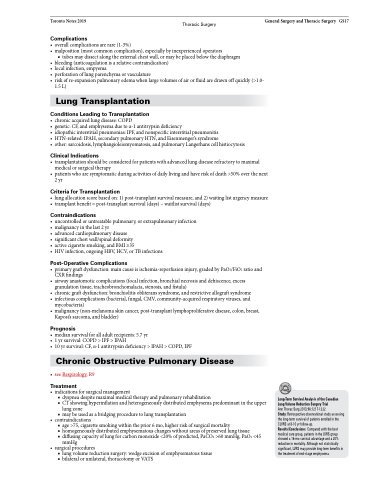Page 419 - TNFlipTest
P. 419
Toronto Notes 2019 Thoracic Surgery General Surgery and Thoracic Surgery GS17
Complications
• overallcomplicationsarerare(1-3%)
• malposition(mostcommoncomplication),especiallybyinexperiencedoperators
■ tubes may dissect along the external chest wall, or may be placed below the diaphragm
• bleeding(anticoagulationisarelativecontraindication)
• localinfection,empyema
• perforationoflungparenchymaorvasculature
• riskofre-expansionpulmonaryedemawhenlargevolumesofairorfluidaredrawnoffquickly(>1.0-
1.5 L)
Lung Transplantation
Conditions Leading to Transplantation
• chronicacquiredlungdisease:COPD
• genetic:CF,andemphysemaduetoα-1antitrypsindeficiency
• idiopathicinterstitialpneumonias:IPF,andnonspecificinterstitialpneumonitis
• HTN-related:IPAH,secondarypulmonaryHTN,andEisenmenger’ssyndrome
• other:sarcoidosis,lymphangioleiomyomatosis,andpulmonaryLangerhanscellhistiocytosis
Clinical Indications
• transplantationshouldbeconsideredforpatientswithadvancedlungdiseaserefractorytomaximal medical or surgical therapy
• patientswhoaresymptomaticduringactivitiesofdailylivingandhaveriskofdeath>50%overthenext 2yr
Criteria for Transplantation
• lungallocationscorebasedon:1)post-transplantsurvivalmeasure,and2)waitinglisturgencymeasure • transplantbenefit=post-transplantsurvival(days)–waitlistsurvival(days)
Contraindications
• uncontrolledoruntreatablepulmonary,orextrapulmonaryinfection • malignancyinthelast2yr
• advancedcardiopulmonarydisease
• significantchestwall/spinaldeformity
• activecigarettesmoking,andBMI≥35
• HIVinfection,ongoingHBV,HCV,orTBinfections
Post-Operative Complications
• primary graft dysfunction: main cause is ischemia-reperfusion injury, graded by PaO2/FiO2 ratio and CXR findings
• airwayanastomoticcomplications(focalinfection,bronchialnecrosisanddehiscence,excess granulation tissue, tracheobronchomalacia, stenosis, and fistula)
• chronicgraftdysfunction:bronchiolitisobliteranssyndrome,andrestrictiveallograftsyndrome
• infectiouscomplications(bacterial,fungal,CMV,community-acquiredrespiratoryviruses,and
mycobacteria)
• malignancy(non-melanomaskincancer,post-transplantlymphoproliferativedisease,colon,breast,
Kaposi’s sarcoma, and bladder)
Prognosis
• mediansurvivalforalladultrecipients:5.7yr
• 1yrsurvival:COPD>IPF>IPAH
• 10yrsurvival:CF,α-1antitrypsindeficiency>IPAH>COPD,IPF
Chronic Obstructive Pulmonary Disease
• seeRespirology,R9
Treatment
• indicationsforsurgicalmanagement
■ dyspnea despite maximal medical therapy and pulmonary rehabilitation
■ CT showing hyperinflation and heterogeneously distributed emphysema predominant in the upper
lung zone
■ may be used as a bridging procedure to lung transplantation
• contraindications
■ age >75, cigarette smoking within the prior 6 mo, higher risk of surgical mortality
■ homogeneously distributed emphysematous changes without areas of preserved lung tissue
■ diffusing capacity of lung for carbon monoxide <20% of predicted, PaCO2 >60 mmHg, PaO2 <45
mmHg
• surgicalprocedures
■ lung volume reduction surgery: wedge excision of emphysematous tissue ■ bilateral or unilateral, thoracotomy or VATS
Long-Term Survival Analysis of the Canadian Lung Volume Reduction Surgery Trial
Ann Thorac Surg 2013;96:1217-1222
Study: Retrospective observational study assessing the long-term survival of patients enrolled in the CLVRS at 8-10 yr follow-up.
Results/Conclusions: Compared with the best medical care group, patients in the LVRS group showed a 16-mo survival advantage and a 20% reduction in mortality. Although not statistically significant, LVRS may provide long-term benefits in the treatment of end-stage emphysema.


